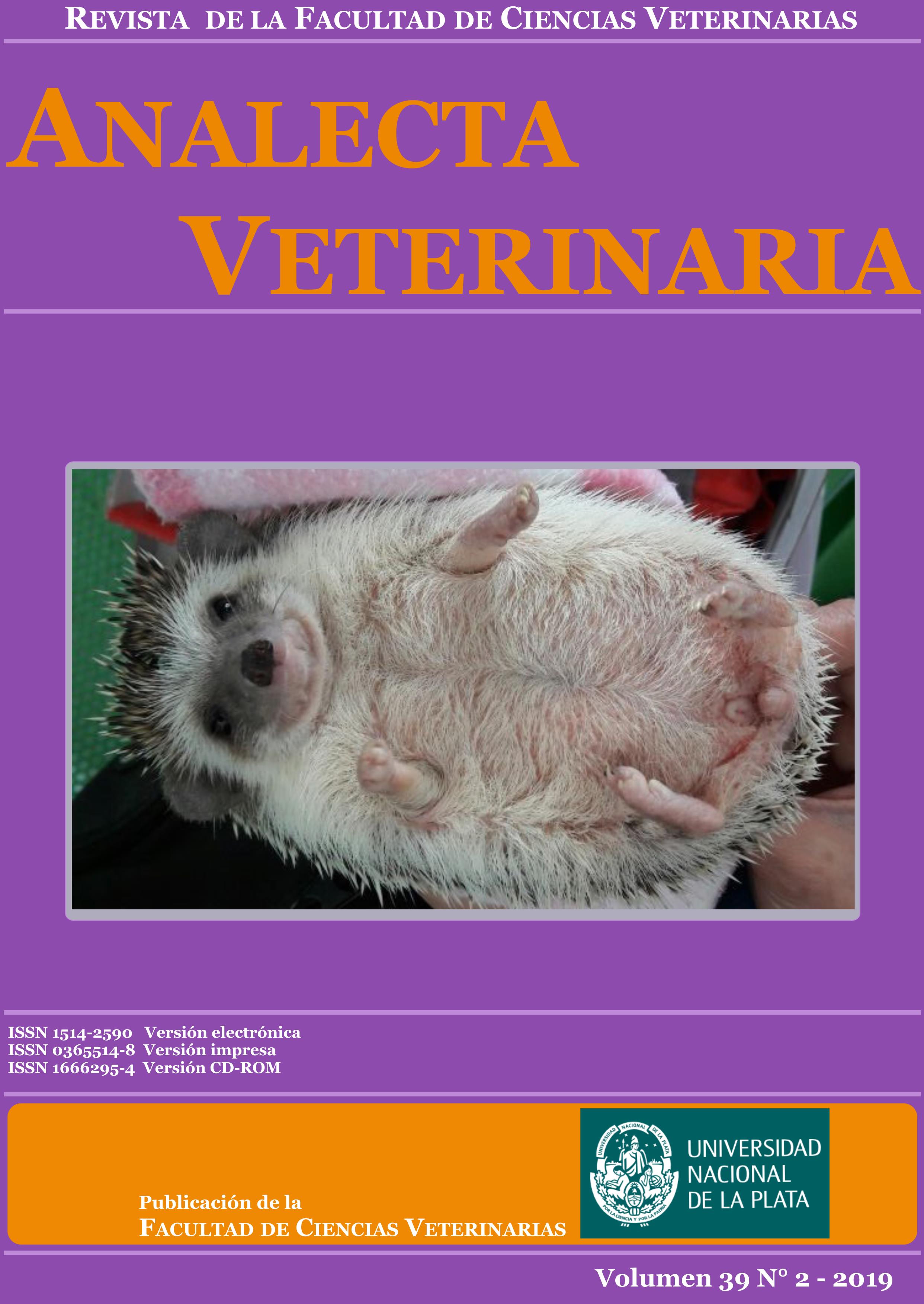Evaluation of the inhibitory power of extracts obtained from medicinal plants on pathogenic enterobacteria relevant in public health
Inhibición de patógenos por aceites esenciales
DOI:
https://doi.org/10.24215/15142590e040Keywords:
Medicinal plants, vegetable extracts, inhibition, pathogenic enterobacteriaAbstract
Vegetable extracts can be obtained from different parts of plants such as leaves, stems, flowers and roots. Interest in vegetable extracts has increased significantly due to their bactericidal, fungicidal and antioxidant properties. For this reason, the objective of this work was to evaluate the inhibitory power of the vegetable substances extracted from four medicinal plants: Schinus molle (molle), Sesamum indicum (sesame) Cinnamomum zeylanicum (cinnamon) and Minthostachys mollis (muña) against ten pathogenic enterobacteria. The extracts were obtained with or without maceration with organic solvents and by aqueous extraction. The extraction methodology that presented the highest inhibitory power was that carried out with organic solvents, while the aqueous extractions were those that presented lower inhibitory power. In the inhibition assays, cinnamon extract showed the greatest inhibitory power against pathogenic enterobacteria, while the cinnamon extract combined with sesame (1:1) showed a synergistic effect enhancing antibacterial activity. In addition, cinnamon presented bactericidal effect against Salmonella ser. typhimurium and Salmonella ser. enteritidis.
Downloads
Metrics
References
Amara AA. El-Masry MH, Bogdady HH. 2008. Plant crude extracts could be the solution: extracts showing antitumorigenic activity. Pakistan Journal of pharmaceutical sciences. 21(2):159-71.
Abadie RE, Medina R, Ruiz L, Tresierra-Ayala A. 2014. Actividad antibacteriana de extractos vegetales frente a cepas intrahospitalarias, Iquitos-Perú. Revista ECIPerú. 11(1):31-8. doi.org/10.33017/RevECIPeru2014.0005/
Alegre A, Iannacone J, Carhuapoma M. 2017. Toxicity of aqueous, ethanolic and hexanic extracts of Annona muricata, Minthostachys mollis, Lupinus mutabilis, and Chenopodium quinoa against Tetranychus urticextractos and Chrysoperla externa, Chilean journal of agricultural & animal sciences. 33(3):273-84. http://dx.doi.org/10.4067/S0719-38902017005000705
Arias JP, Silva GA, Figueroa IC, Fischer SG, Robles-Bermúdez A, Rodríguez-Maciel JC, Lagunes-Tejeda A. 2017. Actividad insecticida, repelente y antialimentaria del polvo y aceite esencial de frutos de Schinus molle L. para el control de Sitophilus zeamais (Motschulsky). Chilean Journal of Agricultural & Animal Sciences. 33(2):93-104. doi: 10.4067/ s0719-38902017005000301
Bozin B, Mimica-Dukic N, Simin N, Anackov G. 2006. Characterization of the volatile composition of essential oils of some lamiaceae spices and the antimicrobial and antioxidant activities of the entire oils. Journal of Agricultural and Food Chemistry. 54(5):1822-28. doi: 10.1021/jf051922u
Burt S. 2004. Essential oils: Their antibacterial properties and potential applications in foods - A review. International Journal of Food Microbiology. 94(3):223-53. doi:10.1016/j.ijfoodmicro.2004.03.022
Castro Montoya JM, Rangel-Peraza JG, Piña-Hernández CJ, Mora-Rochín S, Rochín-Medina JJ. 2015. Actividad antioxidante de compuestos fenólicos en semillas de ajonjolí y su efecto sobre el crecimiento bacteriano. Revista Iberoamericana de Ciencias. Disponible en: http://www.reibci.org/publicados/2015/julio/1000111.pdf
Darré M, Valerga L, Araque LCO, Lemoine ML, Demkura PV, Vicente AR, Concellón A. 2017. Role of UV-B irradiation dose and intensity on color retention and antioxidant elicitation in broccoli florets (Brassica oleracea var. Italica). Postharvest biology and technology,128:76-82. doi:10.1016/j.postharvbio.2017.02.003
Deveci O, Sukan A, Tuzun N, Hames Kocabas EE. 2010. Chemical composition, repellent and antimicrobial activity of Schinus molle L. Journal of Medicinal Plants Research. 4(21):2211-16. doi:10.5897/JMPR10.326
García C, Martínez A, Ortega JL, Castro F. 2010. Componentes químicos y su relación con las actividades biológicas de algunos extractos vegetales. QuímicaViva. 2(1):12-21.
González Villa ÁA. 2004. Obtención de aceites esenciales y extractos etanólicos de plantas del Amazonas (Disertación Doctoral, Universidad Nacional de Colombia-Sede Manizales). Disponible en: www.bdigital.unal.edu.co/1173
Henao Riveros SC. 2003. Actividad bactericida del ácido hipocloroso. Revista Facultad de Medicina, 51(3):136-42.
Herrera Arias F, García-Rico RO. 2006. Evaluación in vitro del efecto bactericida de extractos acuosos de laurel, clavo, canela y tomillo sobre cinco cepas bacterianas patógenas de origen alimentario. Bistua: Revista de la Facultad de Ciencias Básicas, 4(2):13-9.
Huamán S, Hurtado H, Kong V, León C, León D, Lister P, Miñano K, Orrego F, Santillán L, Sánchez M, Vargas E, Castañeda B, Ibañez L.2003. Estudio toxicológico y teratogénico del extracto metanólico de Cinnamomum zeylanicum (canela). Revista Horizonte Médico. 3(1,2):69-78.
Pastrana Puche YI, Durango Villadiego AM, Acevedo Correa D. 2017. Efecto antimicrobiano del clavo y la canela sobre patógenos. Biotecnología en el Sector Agropecuario y Agroindustrial. 15(1):56-65. DOI:10.18684/bsaa(15)56-65
Peredo-Luna HA, Palou-García E, López-Malo A. 2009. Aceites esenciales: métodos de extracción. Temas Selectos de Ingeniería de Alimentos. 3(1):24-32. Disponible en: www.udlap.mx/WP/tsia/files/No3-Vol-1/TSIA-3(1)-Peredo-Luna-et-al-2009.pdf
Rodríguez Pava CN, Zarate Sanabria AG, Sánchez Leal LC. 2017. Actividad antimicrobiana de cuatro variedades de plantas frente a patógenos de importancia clínica en Colombia. Nova. 15(27):119-29.
Sánchez Miranda L. 2013. Determinación de compuestos funcionales en canela (Cinnamomum zeylanicum). Disponible en: https://tesis.ipn.mx/bitstream/handle/123456789/25267/S%C3%81NCHEZ%20MIRANDA%20LUISA.pdfsequence=1&isAllowed=y
Shiva Ramayoni CM. 2007. Estudio de la actividad antimicrobiana de extractos naturales y ácidos orgánicos. Posible alternativa a los antibióticos promotores de crecimiento. Tesis doctoral. Facultat de Veterinària. Universitat Autònoma de Barcelona. Disponible en: www.tdx.cat/bitstream/handle/10803/5606/cmsr1de1.pdf?sequence=1
Wong YC, Ahmad-Mudzaqqir MY,Wan-Nurdiyana WA. 2014. Extraction of essential oil from cinnamon (Cinnamomum zeylanicum). Oriental Journal of Chemistry. 30(1):37-47. DOI:10.13005/ojc/300105
Published
How to Cite
Issue
Section
License
Authors retain the copyright and assign to the journal the right of the first publication, with the with the terms of the Creative Commons attribution license. This type of license allows other people to download the work and share it, as long as credit is granted for the authorship, but does not allow them to be changed in any way or used them commercially.

Analecta Veterinaria by School of Veterinary Sciences, National University of La Plata is distributed under a Creative Commons Attribution-NonCommercial-NoDeriv 4.0 International License.

























